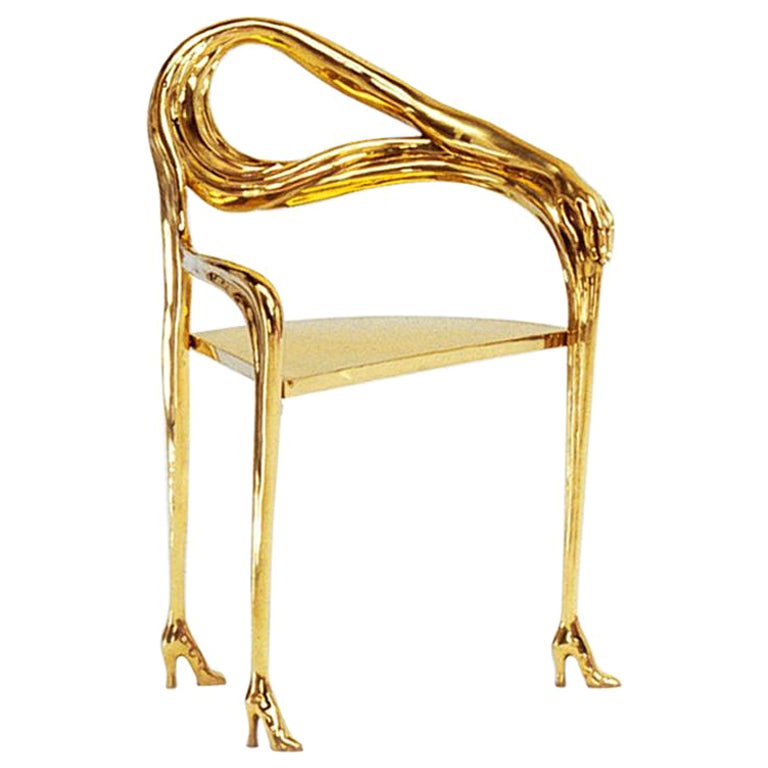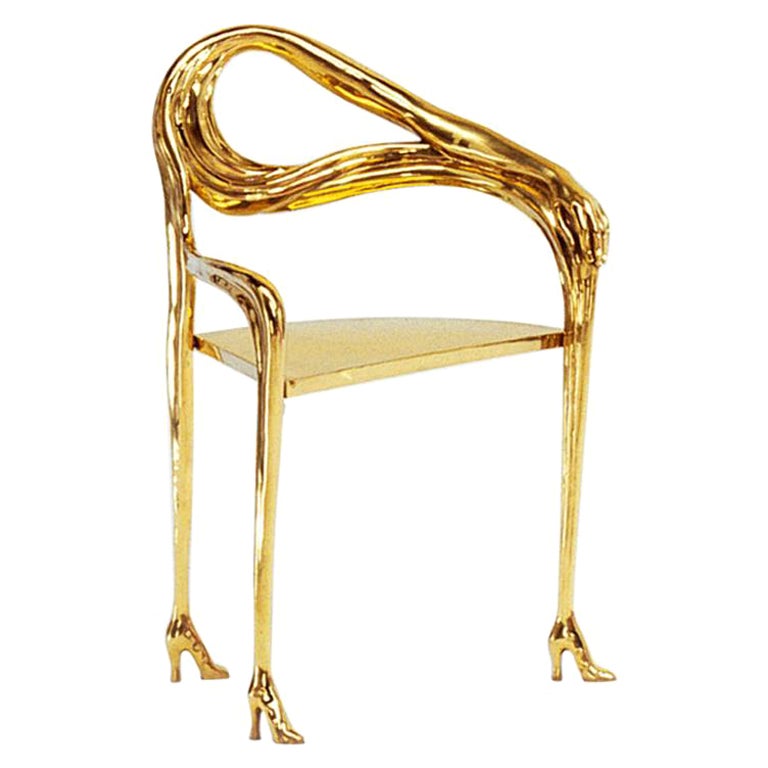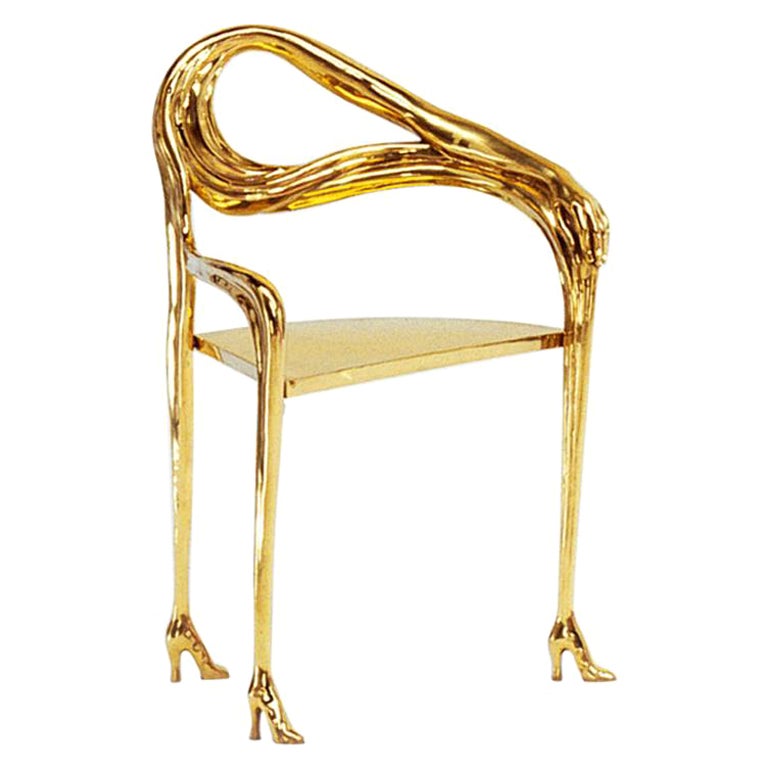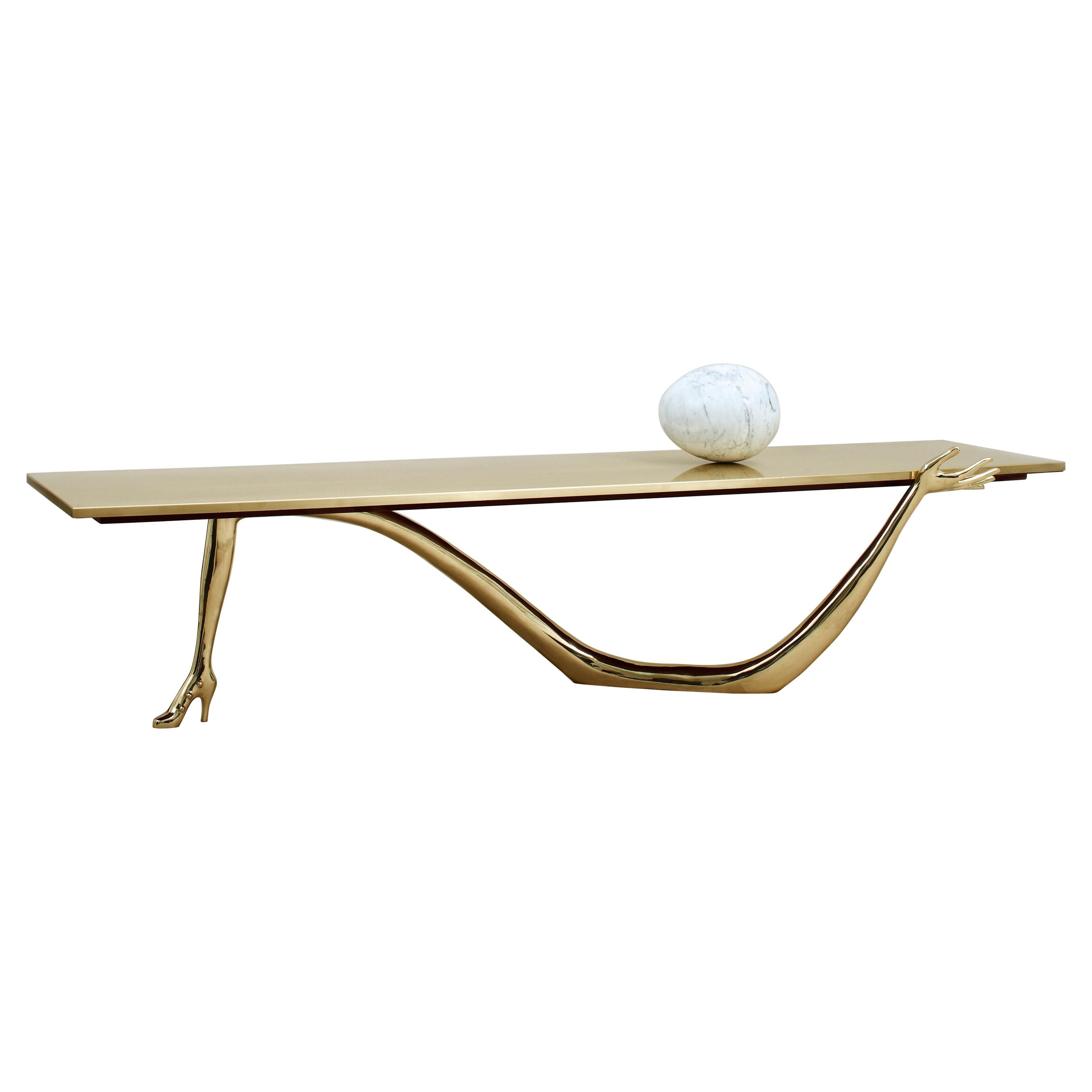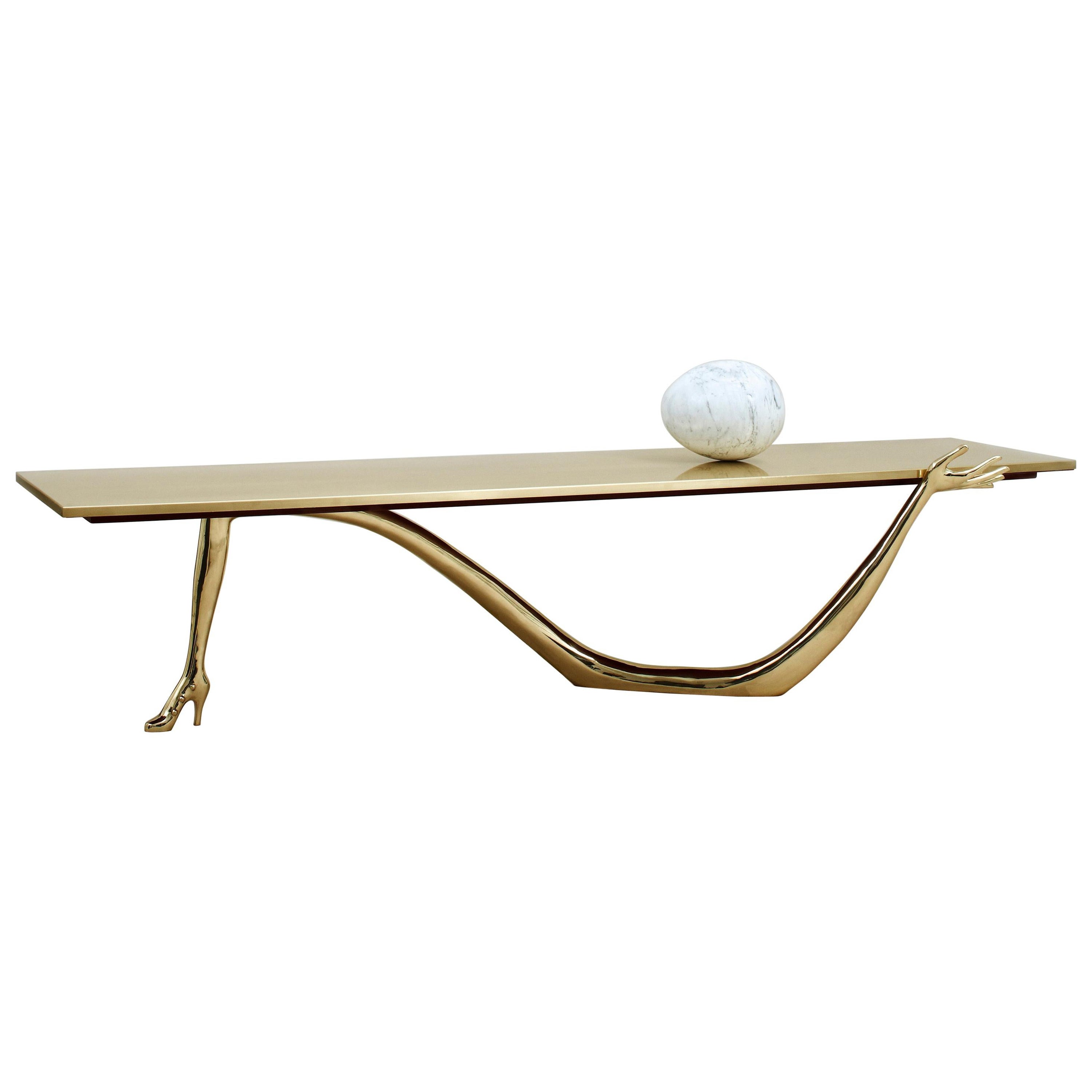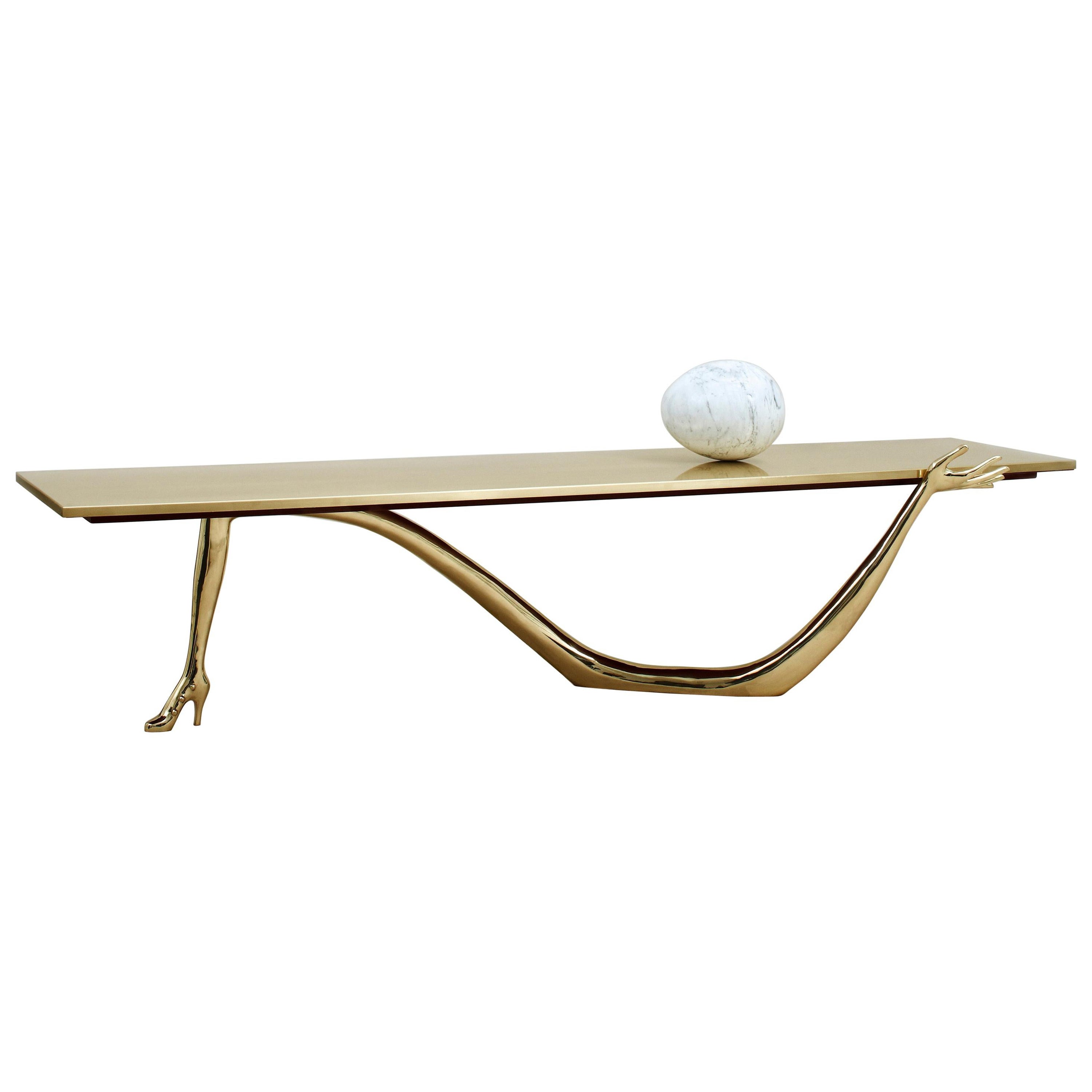"Leda" Armchair Sculpture by Salvador Dalí 20th Century Surrealist design
About the Item
- Creator:Salvador Dalí (Designer),BD Barcelona Design (Manufacturer)
- Dimensions:Height: 36.23 in (92 cm)Width: 23.63 in (60 cm)Depth: 18.51 in (47 cm)
- Style:Modern (In the Style Of)
- Materials and Techniques:Brass,Polished
- Place of Origin:
- Period:
- Date of Manufacture:2023
- Production Type:New & Custom(Current Production)
- Estimated Production Time:9-10 weeks
- Condition:
- Seller Location:Barcelona, ES
- Reference Number:1stDibs: LU3048332559682
Salvador Dalí
Instantly recognizable by his waxed, upturned mustache, the flamboyant Salvador Dalí is one of modern art’s most distinctive figures. He is also one of the icons of the 20-century avant-garde Surrealist movement, whose dreamlike images, drawn from the depths of the unconscious, he deployed in paintings, sculptures, prints and fashion, as well as in film collaborations with Luis Buñuel and Alfred Hitchcock.
Dalí was born in Figueres, Catalonia, and even as a youngster, displayed the sensitivity, sharp perception and vivid imagination that would later define his artworks. In these, he conjured childhood memories and employed religious symbols and Freudian imagery like staircases, keys and dripping candles to create unexpected, often shocking pieces.
Dalí's use of hyperrealism in conveying Surrealist symbols and concepts that subvert accepted notions of reality is epitomized in what is perhaps his most recognizable painting, The Persistence of Memory (1931), in which he depicts the fluidity of time through melting clocks, their forms inspired by Camembert cheese melting in the sun. His artistic genius, eccentric personality and eternal quest for fame made him a global celebrity.
“Each morning when I awake, I experience again a supreme pleasure,” he once said. “That of being Salvador Dalí.”
Find original Salvador Dalí paintings, prints, sculptures and other works on 1stDibs.
- ShippingRetrieving quote...Ships From: BARCELONA, Spain
- Return PolicyA return for this item may be initiated within 2 days of delivery.
- Armchair model "Leda" By Salvador Dalí Spanish surrealist 20th century designBy Salvador Dalí, BD Barcelona DesignLocated in Barcelona, ESArmchair model "Leda" Structure in polished cast brass varnish. Salvador Dali Taken from “Femme à tête de roses" (1935)” 1935 (Woman with a head of roses). It was sufficient for this sculpture to be made as a three dimensional piece, remaining faithful to every detail in Dalí’s painting. Dalí affirmed: “A chair can be used even to sit on, but only on one condition: That we sit uncomfortably.” We can sit on the Leda, but due to the fact that it only has three legs and that the chair is heavy, it being made of solid brass, is more a work of art than a functional piece of furniture. © Salvador Dalí, Fundació Gala-Salvador Dalí, Figueres, 2022 Artworks by Salvador Dalí: © Salvador Dalí, Fundació Gala-Salvador Dalí, VEGAP, Barcelona, 2022 Salvador Dalí is the most versatile and prolific artists of the 20th century and the most famous Surrealist. Though chiefly remembered for his painterly output, in the course of his long career he successfully turned to sculpture, printmaking, fashion, advertising, writing, filmmaking and design. Born in Figueres, Catalonia, Dalí received his formal education in fine arts in Madrid. Influenced by Impressionism and the Renaissance masters from a young age, he became increasingly attracted to Cubism and avant-garde movements. He moved closer to Surrealism in the late 1920s and joined the Surrealist group in 1929, soon becoming one of its leading exponents. In the Paris of the 1930s, Dalí surrounded himself with a circle of friends working in the application of art to a number of varied disciplines, beyond the study of purely pictorial art. One of these, Jean-Michel Frank, an acclaimed furniture designer and decorator in Paris at that time, got on extremely well with Dalí, and together they developed a number of ideas. One example of this is the Bracelli lamp, a classic design in Jean-Michel’s manner of designing and working that Dalí adopted for his home in Portlligat. Among Dalí’s projects, which add to his CV as a designer, are the garden furniture for his home in Portlligat, the complete architecture of the Night Club (in the shape of a hedgehog) for the Hotel Presidente in Acapulco (1957) and a project for a bar in California in the 1940s. His creations were not limited to traditional furniture elements, but included taps, handles, knobs, prints and objects of indeterminate use. In 1933, Dalí even registered the patent for the design of a bench as an outdoor seat. In the 1990s, a team of experts led by Oscar Tusquets set out to bring to life the furniture that Dalí had sketched for Jean-Michel Frank, including the Leda chair and low table taken from the 1935 painting “Femme...Category
21st Century and Contemporary Spanish Modern Armchairs
MaterialsBrass
- Brass armchair model "Leda" By Salvador Dalí 20th Century Spanish designBy Salvador Dalí, BD Barcelona DesignLocated in Barcelona, ESArmchair model "Leda" Structure in polished cast brass varnish. Salvador Dali Taken from “Femme à tête de roses" (1935)” 1935 (Woman with a head of roses). It was sufficient for this sculpture to be made as a three dimensional piece, remaining faithful to every detail in Dalí’s painting. Dalí affirmed: “A chair can be used even to sit on, but only on one condition: That we sit uncomfortably.” We can sit on the Leda, but due to the fact that it only has three legs and that the chair is heavy, it being made of solid brass, is more a work of art than a functional piece of furniture. © Salvador Dalí, Fundació Gala-Salvador Dalí, Figueres, 2022 Artworks by Salvador Dalí: © Salvador Dalí, Fundació Gala-Salvador Dalí, VEGAP, Barcelona, 2022 Salvador Dalí is the most versatile and prolific artists of the 20th century and the most famous Surrealist. Though chiefly remembered for his painterly output, in the course of his long career he successfully turned to sculpture, printmaking, fashion, advertising, writing, filmmaking and design. Born in Figueres, Catalonia, Dalí received his formal education in fine arts in Madrid. Influenced by Impressionism and the Renaissance masters from a young age, he became increasingly attracted to Cubism and avant-garde movements. He moved closer to Surrealism in the late 1920s and joined the Surrealist group in 1929, soon becoming one of its leading exponents. In the Paris of the 1930s, Dalí surrounded himself with a circle of friends working in the application of art to a number of varied disciplines, beyond the study of purely pictorial art. One of these, Jean-Michel Frank, an acclaimed furniture designer and decorator in Paris at that time, got on extremely well with Dalí, and together they developed a number of ideas. One example of this is the Bracelli lamp, a classic design in Jean-Michel’s manner of designing and working that Dalí adopted for his home in Portlligat. Among Dalí’s projects, which add to his CV as a designer, are the garden furniture for his home in Portlligat, the complete architecture of the Night Club (in the shape of a hedgehog) for the Hotel Presidente in Acapulco (1957) and a project for a bar in California in the 1940s. His creations were not limited to traditional furniture elements, but included taps, handles, knobs, prints and objects of indeterminate use. In 1933, Dalí even registered the patent for the design of a bench as an outdoor seat. In the 1990s, a team of experts led by Oscar Tusquets set out to bring to life the furniture that Dalí had sketched for Jean-Michel Frank, including the Leda chair and low table taken from the 1935 painting “Femme...Category
21st Century and Contemporary Spanish Modern Armchairs
MaterialsBrass
- Brass chair model "Leda" by Salvador Dalí surrealist designBy Salvador Dalí, BD Barcelona DesignLocated in Barcelona, ESArmchair model "Leda" Structure in polished cast brass varnish. Salvador Dali Taken from “Femme à tête de roses" (1935)” 1935 (Woman with a head of roses). It was sufficient for this sculpture to be made as a three dimensional piece, remaining faithful to every detail in Dalí’s painting. Dalí affirmed: “A chair can be used even to sit on, but only on one condition: That we sit uncomfortably.” We can sit on the Leda, but due to the fact that it only has three legs and that the chair is heavy, it being made of solid brass, is more a work of art than a functional piece of furniture. © Salvador Dalí, Fundació Gala-Salvador Dalí, Figueres, 2022 Artworks by Salvador Dalí: © Salvador Dalí, Fundació Gala-Salvador Dalí, VEGAP, Barcelona, 2022 Salvador Dalí is the most versatile and prolific artists of the 20th century and the most famous Surrealist. Though chiefly remembered for his painterly output, in the course of his long career he successfully turned to sculpture, printmaking, fashion, advertising, writing, filmmaking and design. Born in Figueres, Catalonia, Dalí received his formal education in fine arts in Madrid. Influenced by Impressionism and the Renaissance masters from a young age, he became increasingly attracted to Cubism and avant-garde movements. He moved closer to Surrealism in the late 1920s and joined the Surrealist group in 1929, soon becoming one of its leading exponents. In the Paris of the 1930s, Dalí surrounded himself with a circle of friends working in the application of art to a number of varied disciplines, beyond the study of purely pictorial art. One of these, Jean-Michel Frank, an acclaimed furniture designer and decorator in Paris at that time, got on extremely well with Dalí, and together they developed a number of ideas. One example of this is the Bracelli lamp, a classic design in Jean-Michel’s manner of designing and working that Dalí adopted for his home in Portlligat. Among Dalí’s projects, which add to his CV as a designer, are the garden furniture for his home in Portlligat, the complete architecture of the Night Club (in the shape of a hedgehog) for the Hotel Presidente in Acapulco (1957) and a project for a bar in California in the 1940s. His creations were not limited to traditional furniture elements, but included taps, handles, knobs, prints and objects of indeterminate use. In 1933, Dalí even registered the patent for the design of a bench as an outdoor seat. In the 1990s, a team of experts led by Oscar Tusquets set out to bring to life the furniture that Dalí had sketched for Jean-Michel Frank, including the Leda chair and low table taken from the 1935 painting “Femme...Category
21st Century and Contemporary Spanish Modern Armchairs
MaterialsBrass
- Brass coffee table model "Leda" by Salvador Dalí 20th Century surrealist designBy Salvador Dalí, BD Barcelona DesignLocated in Barcelona, ESDuring the ‘thirties in Paris, Salvador Dalí surrounded himself with a circle of friends involved in the application of art to varied disciplines, above and beyond the study of pure pictorial art. Jean-Michel Frank, a furniture maker and decorator of recognized prestige in the Paris of those years, was on very good terms with Dalí and together they worked on several ideas. The Bracelli lamp which we present here is a classic design after Jean-Michel’s manner of designing and working, adopted by Dalí for his house at Portlligat. Amongst Dalí ’s specific furnishing projects, and constituting another for his curriculum vitae as a designer, may be counted the garden furnishings for his Portlligat house, the complete architecture of the Night Club (garotte-shaped) for the Hotel Presidente in Acapulco (1957) and another project for a bar in California in the ‘forties. As shown by the small selection now produced and included in this catalogue, Dalí ’s work was not restrictes to the traditional furnishing elements, but included tap fittings, handles, door-pulls, printed fabrics and objets of indeterminate use. In the 1990s a group of experts, led by Oscar Tusquets, set themselves the task of turning the furniture Dalí had drawn for Jean-Michel Frank into reality. Amongst these items were the Leda chair...Category
21st Century and Contemporary Spanish Modern Tables
MaterialsBrass
- 20th Century Spanish Surrealist brass "Leda" coffee table by Salvador DalíBy Salvador Dalí, BD Barcelona DesignLocated in Barcelona, ESCoffee table Spain, 1935/37 DIMENSIONS: Table: 1900x451xh.420mm; Table with egg: 1900x451xh.610mm Legs in a cast varnish brass. Table top in brushed and varnished brass. Carrara marble egg on top. Taken from “Femme à tête de roses" (1935)” 1935 (Woman with a head of roses). It was sufficient for this sculpture to be made as a three dimensional piece, remaining faithful to every detail in Dalí’s painting. During the 1930s in Paris, Salvador Dalí surrounded himself with a circle of friends involved in the application of art to varied disciplines, above and beyond the study of pure pictorial art. Jean-Michel Frank, a furniture maker and decorator of recognized prestige in the Paris of those years, was on very good terms with Dalí and together they worked on several ideas. The Bracelli lamp which we present here is a classic design after Jean-Michel’s manner of designing and working, adopted by Dalí for his house at Portlligat. Amongst Dalí ’s specific furnishing projects, and constituting another for his curriculum vitae as a designer, may be counted the garden furnishings for his Portlligat house, the complete architecture of the Night Club (garotte-shaped) for the Hotel Presidente in Acapulco (1957) and another project for a bar in California in the ‘forties. As shown by the small selection now produced and included in this catalogue, Dalí ’s work was not restricted to the traditional furnishing elements, but included tap fittings, handles, door-pulls, printed fabrics and objets of indeterminate use. In the 1990s a group of experts, led by Oscar Tusquets, set themselves the task of turning the furniture Dalí had drawn for Jean-Michel Frank into reality. Amongst these items were the Leda chair...Category
21st Century and Contemporary Spanish Modern Tables
MaterialsBrass
- Low brass coffee table model "Leda" by Salvador Dalí 20th century spanish designBy Salvador Dalí, BD Barcelona DesignLocated in Barcelona, ESCoffee table Spain, 1935/37 DIMENSIONS: Table: 1900x451xh.420mm; Table with egg: 1900x451xh.610mm Legs in a cast varnish brass. Table top in brushed and varnished brass. Carrara marble egg on top. Taken from “Femme à tête de roses" (1935)” 1935 (Woman with a head of roses). It was sufficient for this sculpture to be made as a three dimensional piece, remaining faithful to every detail in Dalí’s painting. During the 1930s in Paris, Salvador Dalí surrounded himself with a circle of friends involved in the application of art to varied disciplines, above and beyond the study of pure pictorial art. Jean-Michel Frank, a furniture maker and decorator of recognized prestige in the Paris of those years, was on very good terms with Dalí and together they worked on several ideas. The Bracelli lamp which we present here is a classic design after Jean-Michel’s manner of designing and working, adopted by Dalí for his house at Portlligat. Amongst Dalí ’s specific furnishing projects, and constituting another for his curriculum vitae as a designer, may be counted the garden furnishings for his Portlligat house, the complete architecture of the Night Club (garotte-shaped) for the Hotel Presidente in Acapulco (1957) and another project for a bar in California in the ‘forties. As shown by the small selection now produced and included in this catalogue, Dalí ’s work was not restricted to the traditional furnishing elements, but included tap fittings, handles, door-pulls, printed fabrics and objets of indeterminate use. In the 1990s a group of experts, led by Oscar Tusquets, set themselves the task of turning the furniture Dalí had drawn for Jean-Michel Frank into reality. Amongst these items were the Leda chair...Category
21st Century and Contemporary Spanish Modern Tables
MaterialsBrass
- 20th Century Javanese SculptureLocated in Gloucestershire, GBFantastic 20th Century Javanese biomorphic sculpture. This beautiful, hand-carved sculpture depicts waves and floating figures with wonderful movement throughout. It is composed of...Category
20th Century Indonesian Sculptures and Carvings
MaterialsWood
- Mid 20th Century Wooden Mythological SculptureLocated in Yonkers, NYA vintage Thai carved wooden mythological creature from the mid 20th century with gilt finish and red undertone. Capture the enchantment of Thai mythology with this vintage carved wooden statuette from the mid 20th century. Crafted with exquisite attention to detail, this mythical creature is a delightful addition to any art collection or home decor. The statuette showcases a reclined pose, exuding a sense of relaxation and tranquility. With a charming touch, it props one paw against its cheek, creating a whimsical and endearing expression. The statuette's gilt finish with a subtle red undertone adds a touch of opulence and warmth to its overall appearance. The texture of the wooden sculpture is brought to life with carved details, featuring concentric circles and ripple effects that create a sense of movement and depth. These textural elements enhance the visual appeal of the statuette and showcase the skillful craftsmanship of the artist. Adding to its charm, the statuette features a naive style face that capture the innocence and simplicity of traditional Thai art...Category
Mid-20th Century Thai Sculptures and Carvings
MaterialsWood
- 20th Century Chinese Soapstone Guanyin Figure SculptureLocated in Marbella, ES20th century Chinese soapstone Guanyin figure sculpture.Category
Late 20th Century Chinese Sculptures and Carvings
MaterialsStone
- 20th Century Oriental Figure Sculpture in MalachiteLocated in PALERMO, ITValuable sculpture depicting an oriental figure. Made from a single block of flowery malachite. Mounted on a carved wooden base.Category
Early 20th Century Chinese Sculptures and Carvings
MaterialsMalachite
- Large wooden sculpture horse, India, 19th/20th centuryLocated in DEVENTER, NLLarge decorative Indian Hindu woodcarving depicting a horse with an attendant (possibly shiva), used for processions. Polychrome woodcarving. In fair condition, some cracks in the w...Category
Early 20th Century Indian Sculptures and Carvings
MaterialsWood
- Black Soapstone Sculpture "Foo Dog" China 20th CenturyLocated in Prato, ITChina, sec. XX In black soapstone. Traces of red painting. Size: cm 24 x 7 x 18.Category
20th Century Chinese Sculptures and Carvings
MaterialsSoapstone
